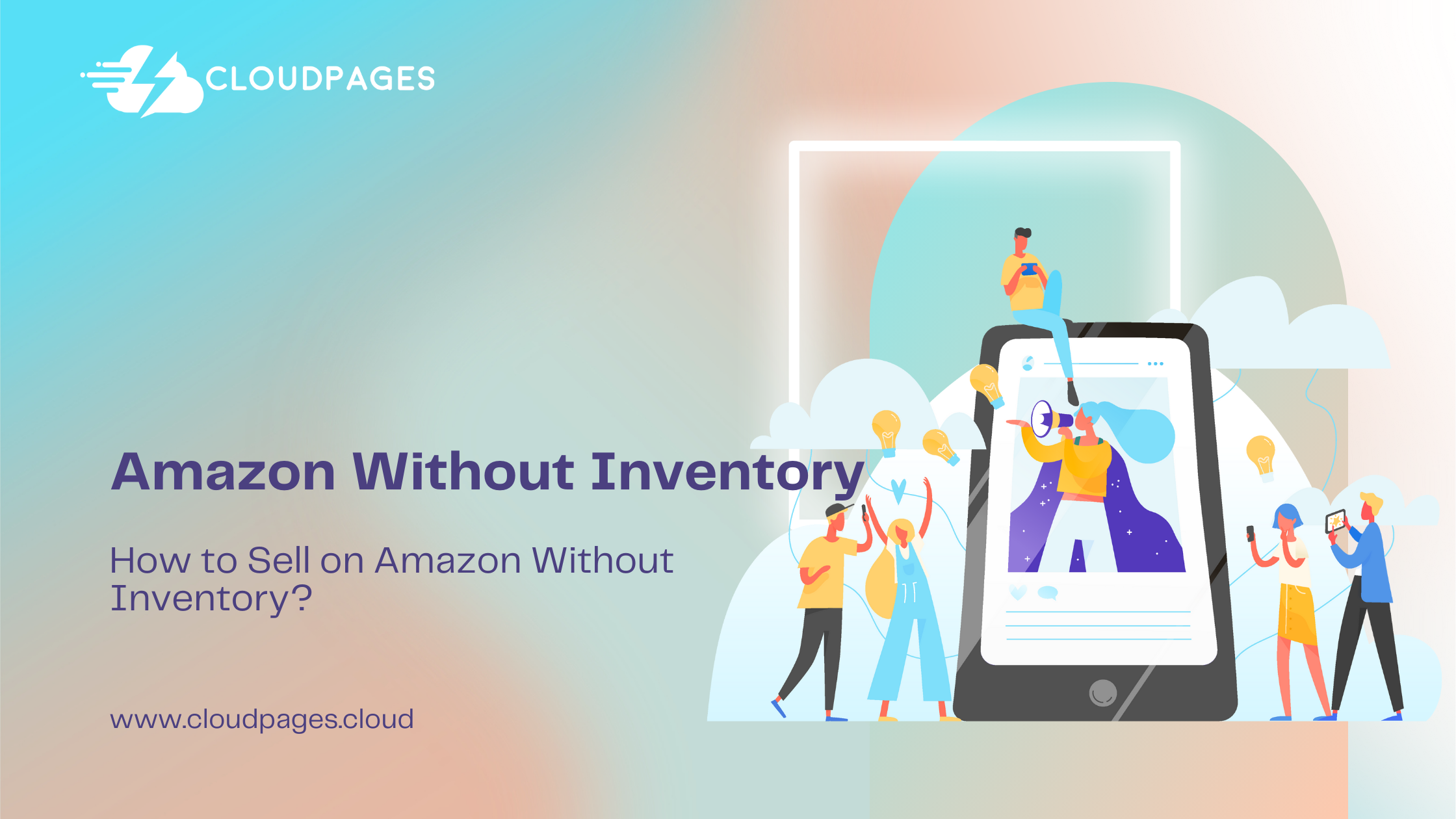The world of e-commerce has witnessed a paradigm shift with the advent of platforms like Amazon, providing unprecedented opportunities for entrepreneurs. One innovative approach gaining traction is the concept of selling on Amazon without maintaining any physical inventory. This revolutionary model has redefined entrepreneurship, making it accessible to a broader audience.
In this comprehensive guide, we will explore the intricacies of how to sell on Amazon without inventory, covering various methods, strategies, and tools to help you navigate this exciting venture.

Table of Contents
Understanding the Concept
Selling on Amazon without inventory is a strategic business model where sellers refrain from stocking products. Instead, they procure items from third-party suppliers only when a sale occurs, allowing them to operate without the traditional costs and management associated with maintaining inventory. This approach often involves dropshipping or utilizing services like Amazon’s Fulfillment by Amazon (FBA).
Exploring the Dropshipping Model
1. Listing Products
- Sellers list products on Amazon without purchasing them upfront.
- Product information is sourced from third-party suppliers’ digital catalogs.
2. Receiving Orders
- When a customer places an order, the seller receives the order details.
3. Order Fulfillment
- The seller purchases the product from the third-party supplier, providing customer shipping details.
4. Shipping the Product
- The third-party supplier packages and ships the product directly to the customer.
- The seller never handles the physical product.
5. Handling Customer Service
- The seller remains responsible for customer service, including inquiries, complaints, and returns.
This model minimizes upfront costs, making it attractive for those seeking low-risk entry into e-commerce. However, its success relies heavily on the reliability and quality of chosen suppliers.
Leveraging Amazon FBA
1. Sending Products to Amazon
- Sellers send their products to Amazon’s fulfillment centers.
- Products are stored until sold.
2. Customer Orders
- When a customer places an order, Amazon picks, packs, and ships the product on behalf of the seller.
3. Customer Service
- Amazon handles customer service and returns for these orders.
While FBA requires upfront product purchases, it eliminates the need for sellers to manage inventory, providing a hands-off approach to fulfillment.
Amazon FBA (Fulfillment by Amazon)
Fulfillment by Amazon, commonly known as FBA, presents an alternative approach to selling without the burden of managing inventory. In the FBA model, sellers dispatch their products to Amazon’s fulfillment centers, where items are stored until they find a buyer. When a customer initiates a purchase, Amazon assumes the responsibility of picking, packing, and shipping the product on behalf of the seller. Additionally, Amazon manages customer service inquiries and handles returns related to these orders.
Despite the requirement for sellers to make upfront product purchases, FBA significantly mitigates the conventional challenges associated with inventory management. Sellers can relinquish concerns about storage space, packaging, shipping logistics, and the complexities of handling returns, as these aspects are expertly managed by Amazon.
Furthermore, FBA provides sellers with the opportunity to capitalize on Amazon’s extensive logistics network and rapid shipping options, including the widely popular Amazon Prime service. This swift and reliable shipping can serve as a compelling selling point for customers seeking prompt delivery.
However, sellers opting for FBA should be cognizant of the associated costs, comprising storage fees and fulfillment fees. It becomes imperative for sellers to factor these expenses into their pricing strategies and profitability calculations, ensuring a comprehensive understanding of the financial dynamics of utilizing Amazon’s FBA service.
Importance of Product Selection
Choosing the right products is crucial for success when selling on Amazon without inventory. Consider the following factors:
1. Market Demand
Select products in high demand to ensure consistent sales.
2. Profit Margins
Opt for products with good profit margins, factoring in supplier costs and customer willingness to pay.
3. Product Size and Weight
Smaller, lightweight products are often more cost-effective to ship.
4. Trend Analysis
Utilize tools like Google Trends to identify products with increasing popularity.
5. Competition Research
Study successful sellers in your niche to understand market dynamics.
Navigating Amazon’s Product Policies: A Crucial Element for a Successful Selling Journey
Selling on Amazon offers unparalleled opportunities, but it comes with the responsibility of adhering to Amazon’s stringent product policies and restrictions. Understanding these guidelines is essential for a smooth and successful selling experience. Here’s a closer look at Amazon’s product policies and why compliance is crucial.
Types of Restricted Products
Amazon has a comprehensive list of restricted products that sellers must be aware of. While the list is extensive, some common categories include:
1. Certain Types of Electronics
Specific electronic items may be restricted due to safety concerns or regulatory requirements.
2. Dangerous Goods
Products classified as dangerous goods, such as flammable materials or certain chemicals, are subject to restrictions.
3. Branded Products
Certain branded products may require approval from the brand owner to prevent counterfeit selling.
Pre-Approval Requirements
Some products on Amazon necessitate pre-approval before sellers can list and sell them. This process ensures that sellers meet specific criteria and guarantees compliance with safety standards and legal requirements. Common examples of products requiring pre-approval include:
1. Restricted Brands
Selling products from certain brands may require authorization from the brand owner to maintain brand integrity and prevent unauthorized reselling.
2. Medical Devices
Items classified as medical devices often require pre-approval due to regulatory considerations and safety concerns.
3. Hazmat Products
Products classified as hazardous materials, such as certain chemicals or batteries, may need pre-approval to ensure safe handling and shipping.
Importance of Accurate Product Listing Information
Accurate and detailed product listings are a cornerstone of Amazon’s policies. Sellers must provide information that is truthful, precise, and complies with all applicable laws. This includes:
1. Product Descriptions
Clearly describe the features, specifications, and uses of the product.
2. Images
Include high-quality images that accurately represent the product.
3. Pricing Information:
Display the product’s price, including any additional fees.
4. Compliance with Laws
Ensure that product listings adhere to all local, national, and international laws and regulations.
Consequences of Non-Compliance
Failure to comply with Amazon’s product policies can have severe consequences for sellers. Amazon is vigilant in enforcing its policies to maintain the integrity of its marketplace. Consequences may include:
1. Selling Privilege Suspension
Amazon may suspend a seller’s privileges temporarily if policy violations are identified.
2. Permanent Removal
In egregious cases or repeated violations, Amazon may permanently remove a seller from the platform.
3. Legal Consequences
Non-compliance can lead to legal actions, including fines or other legal consequences.
Navigating Policies for a Smooth Selling Experience
To ensure a smooth selling experience on Amazon, sellers must prioritize understanding and complying with the platform’s product policies. Here are key steps to navigate these policies effectively:
1. Regular Policy Updates
Stay informed about updates to Amazon’s policies as they can change to reflect evolving industry standards and regulations.
2. Thorough Product Research
Before listing a product, conduct thorough research to understand if it falls under any restricted categories or requires pre-approval.
3. Seek Approval Proactively
For products requiring pre-approval, seek authorization from Amazon or the brand owner well in advance to avoid disruptions in selling.
4. Accurate Product Information
Provide accurate and comprehensive information in product listings to ensure transparency and build trust with customers.
5. Professional Assistance
If unsure about specific policies or compliance requirements, consider seeking professional advice or assistance to navigate Amazon’s complex regulations.
Navigating Amazon’s Policies
Amazon has specific policies regarding the types of products that can be sold, and adherence is crucial to avoiding potential legal issues. Familiarize yourself with these policies, including product restrictions and accurate product listing requirements.
Setting Up Your Amazon Seller Account
Regardless of the inventory model, setting up an Amazon Seller Account is the foundational step. The process involves:
1. Choosing Account Type
Decide between an Individual or Professional account based on your sales volume.
2. Providing Business Information
Fill in essential business details, including legal name, address, and contact information.
3. Setting Up Billing/Deposit Method
Provide a credit card and bank account for fees and sales proceeds.
4. Registering for Tax Purposes
Complete tax information following Amazon’s guidelines.
5. Creating Your Storefront
Choose a store name and set up your Amazon storefront.
6. Listing Products
Start listing products, especially focusing on accurate descriptions and competitive pricing.
Ensuring Quality Customer Service
Maintaining effective customer service is pivotal, especially when selling without inventory. Strategies include:
1. Choosing Reliable Suppliers
Partner with suppliers known for quality and reliability.
2. Regular Communication
Keep open communication with suppliers to stay informed about potential issues.
3. Fast Response Time
Respond promptly to customer inquiries and complaints.
4. Transparent Communication
Inform customers promptly about any order-related issues.
5. Training Your Team
If applicable, ensure your customer service team is well-trained.
Managing and Optimizing Amazon Sales
Regular management and optimization are vital for sustained success. Strategies include:
1. Monitoring Sales Performance
Regularly check sales reports on Amazon Seller Central.
2. Keyword Optimization
Use keyword tools to identify high-performing keywords for product listings.
3. Pricing Adjustments
Utilize repricing tools to adjust prices based on market trends.
4. Quality Product Listings
Ensure product listings are detailed, with clear images and relevant keywords.
5. Amazon Advertising
Leverage Amazon’s advertising options to enhance product visibility.
6. Customer Reviews
Encourage satisfied customers to leave positive reviews.
7. Inventory Management Tools
Use tools for managing third-party supplier stock levels in dropshipping models.
8. Multichannel Sales Reports
Implement tools like Synder for comprehensive sales metrics and bookkeeping.
FAQs
Can you sell on Amazon without stock?
Yes, it is possible to sell on Amazon without maintaining stock through business models like dropshipping or using services such as Amazon FBA (Fulfillment by Amazon). In dropshipping, sellers list products for sale without purchasing them upfront. When a customer places an order, the seller buys the product from a third-party supplier who then ships it directly to the customer. With Amazon FBA, sellers send their products to Amazon’s fulfillment centers, and Amazon handles storage, packing, and shipping when an order is placed.
Can I sell on Amazon if I don’t have a product?
Absolutely. Sellers can leverage various models like dropshipping or utilize Amazon’s FBA service, allowing them to sell on the platform without physically owning or handling the products. The key is to establish partnerships with third-party suppliers who fulfill orders on the seller’s behalf.
How do people make money on Amazon without selling physical products?
People make money on Amazon without selling physical products through digital products, such as e-books, online courses, or software. Additionally, they can earn income through affiliate marketing by promoting and earning commissions on products sold by other sellers. Kindle Direct Publishing (KDP) is another avenue for authors to self-publish and sell their books digitally.
Do you need stock to sell on Amazon?
While having physical stock is one traditional way to sell on Amazon, it’s not the only method. With drop shipping, sellers list products without holding inventory, purchasing items only when a sale is made. Amazon FBA is another option, where sellers send stock to Amazon’s fulfillment centers, and Amazon manages the storage, packing, and shipping when a product is sold. Both approaches allow sellers to operate without maintaining their stock.
Conclusion
Selling on Amazon without inventory opens doors to a dynamic and low-risk e-commerce venture. Whether through dropshipping or utilizing Amazon FBA, mastering this approach requires meticulous planning, supplier management, and continuous optimization. By understanding the nuances of inventory-free selling and implementing proven strategies, entrepreneurs can capitalize on the vast opportunities Amazon offers while minimizing traditional business complexities. Embark on this journey with confidence, and transform your e-commerce aspirations into a flourishing reality.



